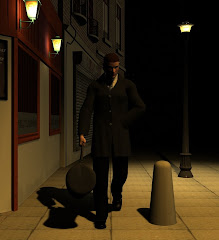It was just a story heard in a pub so I'm not sure if it's true. I'd like to think so, however. A supermarket recently claimed we had forgotten the true meaning of Easter eggs. They symbolise the rebirth of Christ, apparently. And so, by extension, buying and gorging mounds of chocolate at this time of year is our holy duty. Actual Christians complained about this so loudly that the supermarket was forced to apologise.
We thought that they weren't creative enough. They could have said, for example, that the crucifix was actually oval shaped. Or perhaps Jesus himself was. Why stop, too, with appropriating eggs? Take the Easter Bunny, for example. Perhaps this came about because when Christ rose from the tomb, he hop-hoppity-hopped away from it.
Of course eggs and bunnies aren't Christian images. They are pagan ones, just like holly and mistletoe and fir trees. There was a festival at springtime and another in midwinter long before Christianity emerged. They were linked directly to the seasons and their symbols reflect this. The winter ones are reassurances, plants which remain green when everything else has died. In spring comes a celebration, images of life and rebirth. The eggs are obvious, a more direct and less gooey substitute for the womb. The Easter bunny began as the March hare, which was rather mystifyingly given great significance by the old religions. The two are linked, incidentally; it was believed that hares hatched from eggs. Which were laid by lapwings, it seems, on the basis that both creatures live in fields. Clear logic was something else yet to appear in these societies.
It's obvious why the early Christian church appropriated the old festivals. The missionaries were doing a selling job. They wanted to give people something clearly recognisable and which didn't interfere with their pleasures too much. The Nativity didn't quite fit with the old solstice festival but did offer a cause for a straightforward celebration, something always needed in the middle of a grim winter. The Easter story, meanwhile, is perfect for spring. At its heart is death and rebirth. Jesus falls, lies in a tomb and rises again. You can take that, on one level, as a metaphor for the crops withering in autumn and miraculously springing to life again when the seasons change.
There are some Christians who don't like this. Now they've got the old festivals, they want to strip the last remaining pagan symbols from them. Get the Christmas trees out of Christmas, the Easter eggs out of Easter. Let's focus on what really matters. This always strikes me as rather ungrateful, turning on your sponsors when you no longer need them. It's a peculiarly irreligious attitude too. After all, holy events aren't just ones which happened two thousand years ago to a narrow cast of characters. Look at other images of Easter: daffodils, blossom, fluffy chicks. They can be rather hard to take on a full stomach, but in their purest form they are symbols of life. Life suddenly bursting out, life at its most unexpected and glorious. And if you can't see the touch of God in these constant miracles, what exactly is the point in believing in Him?
We thought that they weren't creative enough. They could have said, for example, that the crucifix was actually oval shaped. Or perhaps Jesus himself was. Why stop, too, with appropriating eggs? Take the Easter Bunny, for example. Perhaps this came about because when Christ rose from the tomb, he hop-hoppity-hopped away from it.
Of course eggs and bunnies aren't Christian images. They are pagan ones, just like holly and mistletoe and fir trees. There was a festival at springtime and another in midwinter long before Christianity emerged. They were linked directly to the seasons and their symbols reflect this. The winter ones are reassurances, plants which remain green when everything else has died. In spring comes a celebration, images of life and rebirth. The eggs are obvious, a more direct and less gooey substitute for the womb. The Easter bunny began as the March hare, which was rather mystifyingly given great significance by the old religions. The two are linked, incidentally; it was believed that hares hatched from eggs. Which were laid by lapwings, it seems, on the basis that both creatures live in fields. Clear logic was something else yet to appear in these societies.
It's obvious why the early Christian church appropriated the old festivals. The missionaries were doing a selling job. They wanted to give people something clearly recognisable and which didn't interfere with their pleasures too much. The Nativity didn't quite fit with the old solstice festival but did offer a cause for a straightforward celebration, something always needed in the middle of a grim winter. The Easter story, meanwhile, is perfect for spring. At its heart is death and rebirth. Jesus falls, lies in a tomb and rises again. You can take that, on one level, as a metaphor for the crops withering in autumn and miraculously springing to life again when the seasons change.
There are some Christians who don't like this. Now they've got the old festivals, they want to strip the last remaining pagan symbols from them. Get the Christmas trees out of Christmas, the Easter eggs out of Easter. Let's focus on what really matters. This always strikes me as rather ungrateful, turning on your sponsors when you no longer need them. It's a peculiarly irreligious attitude too. After all, holy events aren't just ones which happened two thousand years ago to a narrow cast of characters. Look at other images of Easter: daffodils, blossom, fluffy chicks. They can be rather hard to take on a full stomach, but in their purest form they are symbols of life. Life suddenly bursting out, life at its most unexpected and glorious. And if you can't see the touch of God in these constant miracles, what exactly is the point in believing in Him?

No comments:
Post a Comment